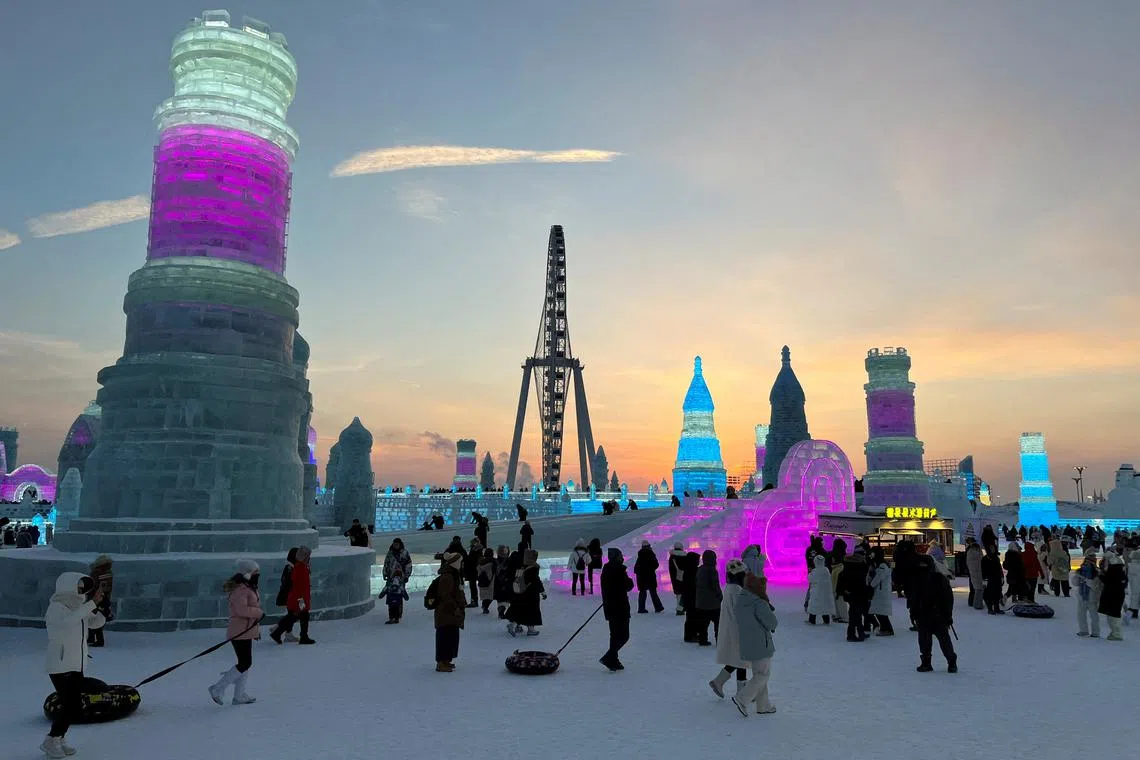Icy Harbin warmed hearts to become a tourist hot spot. Can other Chinese cities do the same?
Sign up now: Get insights on Asia's fast-moving developments

Between Dec 30, 2023, and Jan 1, 2024, Harbin welcomed more than three million visitors.
PHOTO: REUTERS
Follow topic:
BEIJING - China’s north-eastern provinces are frosty places not known for their service.
But even as tourists to Harbin, capital of Heilongjiang province, slipped and fell on its iced-over ground in January, the local authorities rolled out the proverbial red carpet for these out-of-towners.
City employees worked for 40 hours to install a grey carpet along its main shopping drag, Central Street, and down a flight of stairs to an underpass.
Harbin, a Russian colonial city from 1898 to 1917, even created a “moon shot” for tourists. It floated an inflatable sphere over the 117-year-old St Sophia’s Cathedral when tourists gave feedback on social media that they would like a “moon” to appear in their photos of the 53m-tall church, one of the city’s top attractions.
The carpet, fake moon and other tourist-friendly moves have paid off for Harbin.
The city rang up a record 16.42 billion yuan (S$3.1 billion) in tourism during the Golden Week from Feb 10 to 17, the country’s official Chinese New Year break. About 10 million tourists visited Harbin, an 81 per cent increase from the same period a year ago.
Between Dec 30, 2023, and Jan 1, 2024, Harbin welcomed more than three million visitors, with tourism revenue for the three days amounting to about 5.91 billion yuan, also a peak.

Visitors surrounded by ice sculptures at the Harbin Ice and Snow Festival in Harbin, Heilongjiang province.
PHOTO: REUTERS
Before Harbin, there was Zibo, a city in eastern Shandong province.
In 2023, millions of domestic visitors flocked to Zibo
The undergraduates, about 12,000 of them, had been quarantined in Zibo in late 2022 when China’s zero-Covid measures were still in place. To celebrate their release, Zibo officials treated the students to the local barbecued speciality
Many did, along with millions of others who had heard about Zibo on social media.
In March 2023 alone, 4.8 million visitors swarmed Zibo, which has a population of 4.7 million. The response was so overwhelming that the local tourism bureau sent out an advisory on April 26 asking tourists not to visit during the week-long May Day break.
With many Chinese cities keen to emulate the success of Zibo and Harbin, what are the factors behind their popularity with tourists?
One key factor, say experts, is the role of social media.
Ms Ashley Dudarenok, founder of Chozan, a digital consultancy with offices in Shenzhen, Hong Kong and Shanghai, said both have successfully leveraged social media and online platforms to gain attention. “Memorable stories, visually appealing content, and the ability to evoke emotions have been key factors in capturing public interest,” she said.
In Zibo, the local authorities and businesses cashed in on the online buzz, establishing special tourist trains and bus routes to draw visitors, especially the young and social media-savvy crowd, she added.
Ms Olivia Plotnick, who runs social media marketing agency Wai Social in Shanghai, said Harbin excelled in amplifying its appeal by tapping the Internet culture through memes and short videos.
Monikers such as “Little Potatoes from the South”, which refers to tourists from southern China visiting Harbin, and “Little Sugar Orange”, describing a group of visiting children from the Guangxi autonomous region, not only showcased Harbin’s distinct allure but also fostered greater affinity with online audiences, she said.
Hashtags paid off for Harbin.
Ms Dudarenok said hashtags related to Harbin’s tourism boom, such as “Bingxue Big World”, “north-eastern dialect” and “southern little potatoes”, went viral, with over one billion reads each.
The Bingxue Big World – a world-renowned theme park also known as Ice and Snow World that set a new Guinness World Record in 2023 as the largest temporary ice and snow amusement park – is Harbin’s biggest tourism draw.
“The #Harbin hashtag reached an extraordinary 24.74 billion views on Douyin (Chinese TikTok) this year, demonstrating the sheer volume of user engagement and interest,” Ms Dudarenok noted.
Both Zibo and Harbin raised service standards.
In Zibo, the local authorities kept a close eye on how locals, particularly businesses, treated tourists to make sure that they had a good experience. For instance, hotels that tried to overcharge to exploit the surge in visitors were punished.
“That is a learning point for Harbin, which used to have a more nonchalant attitude towards visitors’ experience,” said economics professor Li Kai of Northeastern University in Shenyang in Liaoning province.
Harbin went the extra mile by offering visitors free rides on hot air balloons and armoured tanks, as well as special fireworks shows. The city also organised a street parade featuring the Oroqen people, one of China’s rarest ethnic minorities, and offered photo spots where tourists could take pictures with local animals such as the red-crowned crane and the arctic fox, not to mention penguins carrying backpacks.
Prof Li said “it’s unheard of that a dongbei (north-eastern) city will go to such lengths to draw tourism”, given that China’s north-eastern region, which comprises Heilongjiang, Liaoning and Jilin provinces, is not known for service standards.

Tourists at the annual Harbin Ice and Snow World, in Harbin, China, on Jan 2.
PHOTO: EPA-EFE
On social media, videos of cultural performances to welcome tourists at the airport, as well as those of Harbin locals offering visitors free rides in their cars, have been widely shared.
Prof Li added: “The government has played a key role in leading the way for the city to draw tourists, and getting the buy-in from Harbin residents to be a good host.”
The rewards have been handsome for Harbin and Zibo.
For Harbin, tourism dollars are crucial to topping up the local government’s coffers, which had been depleted in recent years by a surge in pandemic spending and a plunge in land sales.
By some conservative estimates, Harbin has a debt nine times over its available financial resources in 2023. A report by the state-backed National Institution for Finance and Development said in January 2024 that China’s debt-to-gross domestic product ratio in 2023 rose to a high of 287.8 per cent, 13.5 percentage points higher than a year earlier.
Zibo was an obscure industrial city on the decline before tourists revitalised it. The city has now become a household name in China, and seen a wave of new tourism businesses, though it has welcomed fewer visitors during the current winter season.
Local governments across China, from the central Henan province to the northern Hebei and north-eastern Liaoning provinces, have even sent study teams to learn from Zibo.
But it is not that easy to replicate Zibo’s success.
For example, Shijiazhuang, the provincial capital of Hebei, has tried to promote itself as the home of rock and roll – a pun on its name “Shijiazhuang” (“shi” means rock and “jiazhuang” means home in Chinese). In the summer of 2023, the city rolled out rock music concerts in a bid to draw visitors, but was nowhere as successful as Zibo or Harbin.
Said Ms Plotnick: “Not every local government possesses the requisite conditions and capabilities to orchestrate such events or achieve similar outcomes. Like any successful brand, it necessitates a compelling ‘story’ and precise execution at every step.”


